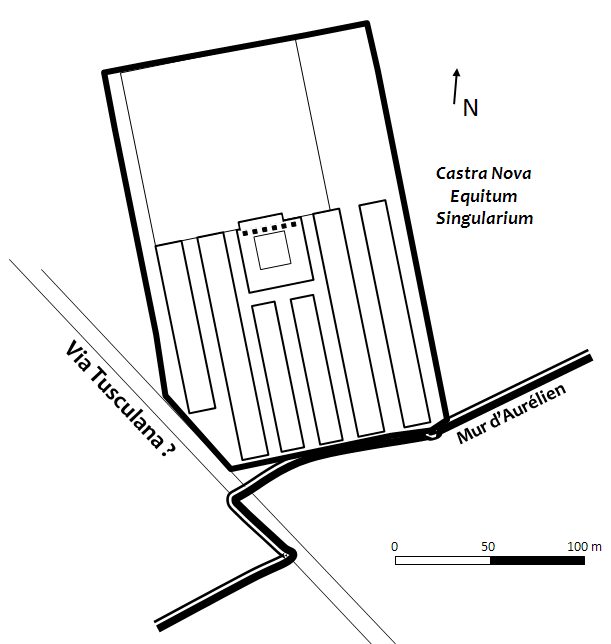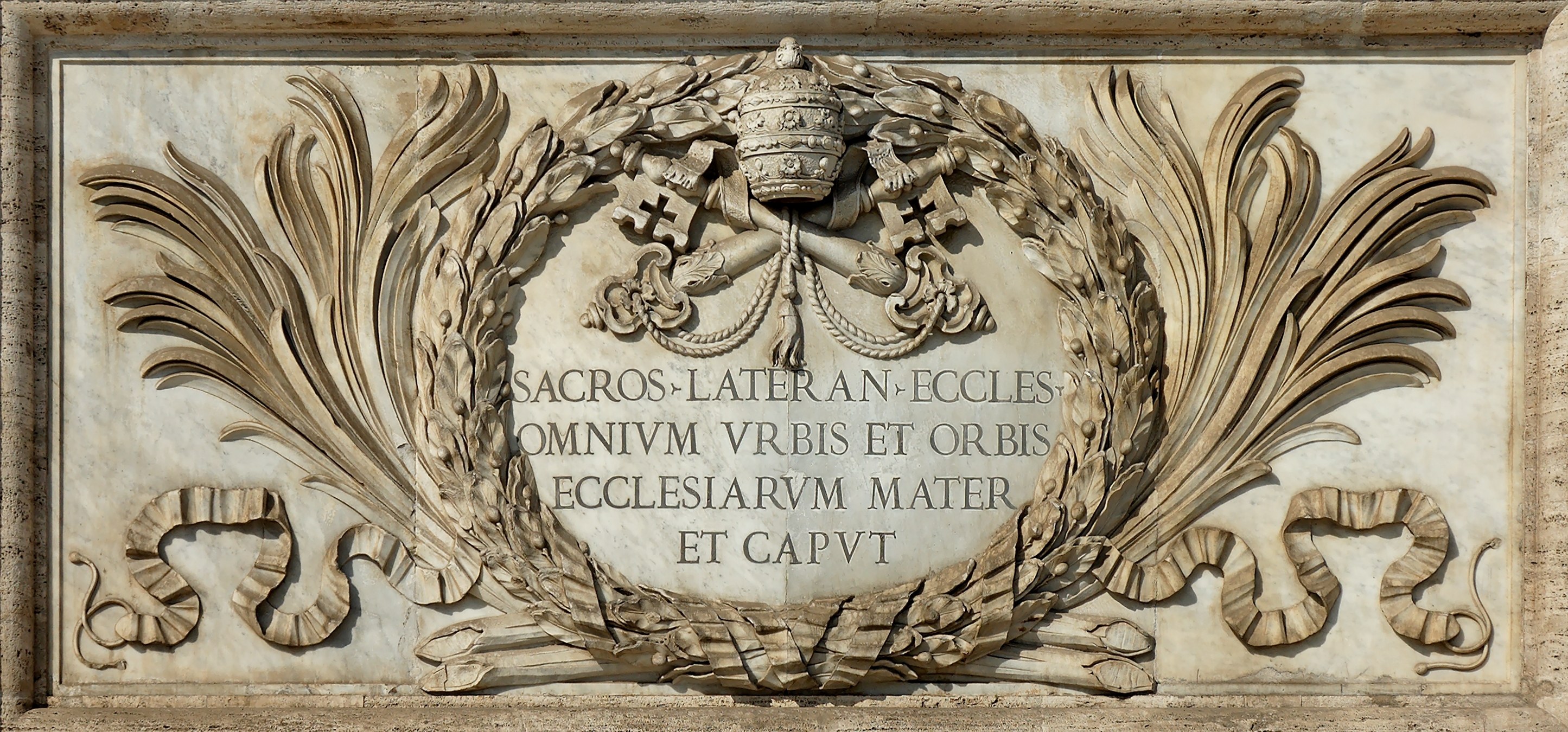|
Castra Nova Equitum Singularium
The Castra Nova equitum singularium was an ancient Roman fort in Rome housing part of the emperor's cavalry bodyguard. The site of the fort now lies beneath the Basilica of St John Lateran. The ''Castra Nova'', or "new fort", was one of two cavalry forts that provided a base in Rome for the mounted bodyguard of the Roman emperors (the ''Equites singulares Augusti''). The Castra Nova was so-called because it was the newer of the two forts, built to house an enlargement of the cavalry guard. Their previous fort ''Castra Prioria'' which lay not far away to the north had been built earlier, possibly under the emperor Domitian, and still housed the original force of 1500 mounted troopers. The full name of the fort is ''Castra nova Equitum singularium Augusti''. History The fort can be precisely dated to AD 193, at the beginning of the reign of Septimius Severus. The new camp was necessitated by this emperor's increase in the size of his cavalry guard from 1,500 to 2,000 men. T ... [...More Info...] [...Related Items...] OR: [Wikipedia] [Google] [Baidu] |
Nave
The nave () is the central part of a church, stretching from the (normally western) main entrance or rear wall, to the transepts, or in a church without transepts, to the chancel. When a church contains side aisles, as in a basilica-type building, the strict definition of the term "nave" is restricted to the central aisle. In a broader, more colloquial sense, the nave includes all areas available for the lay worshippers, including the side-aisles and transepts.Cram, Ralph Adams Nave The Catholic Encyclopedia. Vol. 10. New York: Robert Appleton Company, 1911. Accessed 13 July 2018 Either way, the nave is distinct from the area reserved for the choir and clergy. Description The nave extends from the entry—which may have a separate vestibule (the narthex)—to the chancel and may be flanked by lower side-aisles separated from the nave by an arcade. If the aisles are high and of a width comparable to the central nave, the structure is sometimes said to have three nave ... [...More Info...] [...Related Items...] OR: [Wikipedia] [Google] [Baidu] |
Lexicon Topographicum Urbis Romae
The ''Lexicon Topographicum Urbis Romae'' (1993–2000) is a six-volume, multilingual reference work considered to be the major, modern work covering the topography of ancient Rome The topography of ancient Rome is the description of the built environment of the city of ancient Rome. It is a multidisciplinary field of study that draws on archaeology, epigraphy, cartography and philology. The word 'topography' here has its .... The editor is Eva Margareta Steinby, and the publisher is Edizioni Quasar of Rome. It is considered the successor to Platner and Ashby's '' A Topographical Dictionary of Ancient Rome''. An ongoing series of supplements provides additional coverage of Roman topography and important topics in the archaeology of the city. #M. A. Tomei and P. Liverani. ''Lexicon topographicum urbis Romae. Supplementum. I, Carta archeologica di Roma. Primo quadrante''. Rome: Edizioni Quasar, 2005. . # F. Coarelli. ''Lexicon topographicum urbis Romae. / Supplementum II. 1, Gl ... [...More Info...] [...Related Items...] OR: [Wikipedia] [Google] [Baidu] |
Minerva
Minerva (; ; ) is the Roman goddess of wisdom, justice, law, victory, and the sponsor of arts, trade, and strategy. She is also a goddess of warfare, though with a focus on strategic warfare, rather than the violence of gods such as Mars. Beginning in the second century BC, the Romans equated her with the Greek goddess Athena.''Larousse Desk Reference Encyclopedia'', Book People, Haydock, 1995, p. 215. Minerva is one of the three Roman deities in the Capitoline Triad, along with Jupiter and Juno. Minerva is a virgin goddess. Her domain includes music, poetry, medicine, wisdom, commerce, weaving, and the crafts. Minerva is often depicted with her sacred creature, an owl usually named the " owl of Minerva" which symbolised her association with wisdom and knowledge, as well as, less frequently, the snake and the olive tree. Minerva is commonly depicted as tall with an athletic and muscular build. She is often wearing armour and carrying a spear. As an important Roman g ... [...More Info...] [...Related Items...] OR: [Wikipedia] [Google] [Baidu] |
Consulship
The consuls were the highest elected public officials of the Roman Republic ( to 27 BC). Romans considered the consulship the second-highest level of the ''cursus honorum''an ascending sequence of public offices to which politicians aspiredafter that of the censor, which was reserved for former consuls. Each year, the Centuriate Assembly elected two consuls to serve jointly for a one-year term. The consuls alternated each month holding '' fasces'' (taking turns leading) when both were in Rome. A consul's ''imperium'' (military power) extended over Rome and all its provinces. Having two consuls created a check on the power of any one individual, in accordance with the republican belief that the powers of the former kings of Rome should be spread out into multiple offices. To that end, each consul could veto the actions of the other consul. After the establishment of the Empire (27 BC), the consuls became mere symbolic representatives of Rome's republican heritage and hel ... [...More Info...] [...Related Items...] OR: [Wikipedia] [Google] [Baidu] |
Capital (architecture)
In architecture, the capital () or chapiter forms the topmost member of a column (or a pilaster). It mediates between the column and the load thrusting down upon it, broadening the area of the column's supporting surface. The capital, projecting on each side as it rises to support the abacus, joins the usually square abacus and the usually circular shaft of the column. The capital may be convex, as in the Doric order; concave, as in the inverted bell of the Corinthian order; or scrolling out, as in the Ionic order. These form the three principal types on which all capitals in the classical tradition are based. The Composite order was formalized in the 16th century following Roman Imperial examples such as the Arch of Titus in Rome. It adds Ionic volutes to Corinthian acanthus leaves. From the highly visible position it occupies in all colonnaded monumental buildings, the capital is often selected for ornamentation; and is often the clearest indicator of the architec ... [...More Info...] [...Related Items...] OR: [Wikipedia] [Google] [Baidu] |
Ionic Order
The Ionic order is one of the three canonic classical order, orders of classical architecture, the other two being the Doric order, Doric and the Corinthian order, Corinthian. There are two lesser orders: the Tuscan order, Tuscan (a plainer Doric), and the rich variant of Corinthian called the composite order. Of the three classical canonic orders, the Corinthian order has the narrowest columns, followed by the Ionic order, with the Doric order having the widest columns. The Ionic capital is characterized by the use of volutes. Ionic columns normally stand on a base which separates the shaft of the column from the stylobate or platform while the cap is usually enriched with egg-and-dart. The ancient architect and architectural historian Vitruvius associates the Ionic with feminine proportions (the Doric representing the masculine). Description Capital The major features of the Ionic order are the volutes of its capital (architecture), capital, which have been the subject of mu ... [...More Info...] [...Related Items...] OR: [Wikipedia] [Google] [Baidu] |
St John Lateran
The Archbasilica of Saint John Lateran (officially the ''Major Papal, Patriarchal and Roman Archbasilica, Metropolitan and Primatial Cathedral of the Most Holy Savior and Saints John the Baptist and the Evangelist in Lateran, Mother and Head of All Churches in Rome and in the World''), commonly known as the Lateran Basilica or Saint John Lateran, is the Catholic cathedral of the Diocese of Rome in the city of Rome, Italy. It serves as the seat of the bishop of Rome, the pope. The only "''arch''basilica" in the world, it lies outside of Vatican City proper, which is located approximately northwest. Nevertheless, as properties of the Holy See, the archbasilica and its adjoining edifices enjoy an extraterritorial status from Italy, pursuant to the terms of the Lateran Treaty of 1929. Dedicated to Christ the Savior, in honor of John the Baptist and John the Evangelist, the place name – (Lateran) – comes from an ancient Roman family (''gens''), whose palace (''domus'') grounds o ... [...More Info...] [...Related Items...] OR: [Wikipedia] [Google] [Baidu] |
Castra Nova Excavation
''Castra'' () is a Latin term used during the Roman Republic and Roman Empire for a military 'camp', and ''castrum'' () for a 'fort'. Either could refer to a building or plot of land, used as a fortified military base.. Included is a discussion about the typologies of Roman fortifications. In English usage, ''castrum'' commonly translates to "Roman fort", "Roman camp" and "Roman fortress". Scholastic convention tends to translate ''castrum'' as "fort", "camp", "marching camp" or "fortress". Romans used the term ''castrum'' for different sizes of camps – including large legionary fortresses, smaller forts for cohorts or for auxiliary forces, temporary encampments, and "marching" forts. The diminutive form ''castellum'' was used for fortlets, typically occupied by a detachment of a cohort or a ''centuria''. Etymology ''Castrum'' appears in Oscan and Umbrian, two other Italic languages, suggesting an origin at least as old as Proto-Italic language. Julius Pokorny traces a ... [...More Info...] [...Related Items...] OR: [Wikipedia] [Google] [Baidu] |
Septimius Severus
Lucius Septimius Severus (; ; 11 April 145 – 4 February 211) was Roman emperor from 193 to 211. He was born in Leptis Magna (present-day Al-Khums, Libya) in the Roman province of Africa. As a young man he advanced through cursus honorum, the customary succession of offices under the reigns of Marcus Aurelius and Commodus. Severus was the final contender to seize power after the death of the emperor Pertinax in 193 during the Year of the Five Emperors. After deposing and killing the incumbent emperor Didius Julianus, Severus fought his rival claimants, the Roman generals Pescennius Niger and Clodius Albinus. Niger was defeated in 194 at the Battle of Issus (194), Battle of Issus in Cilicia (Roman province), Cilicia. Later that year Severus waged a short punitive campaign beyond the eastern frontier, annexing the Osroene, Kingdom of Osroene as a new province. Severus defeated Albinus three years later at the Battle of Lugdunum in Roman Gaul, Gaul. Following the consolidation of ... [...More Info...] [...Related Items...] OR: [Wikipedia] [Google] [Baidu] |




